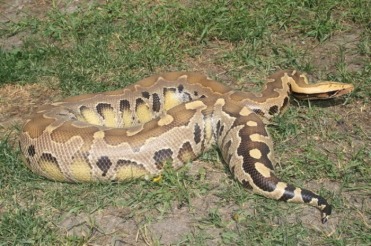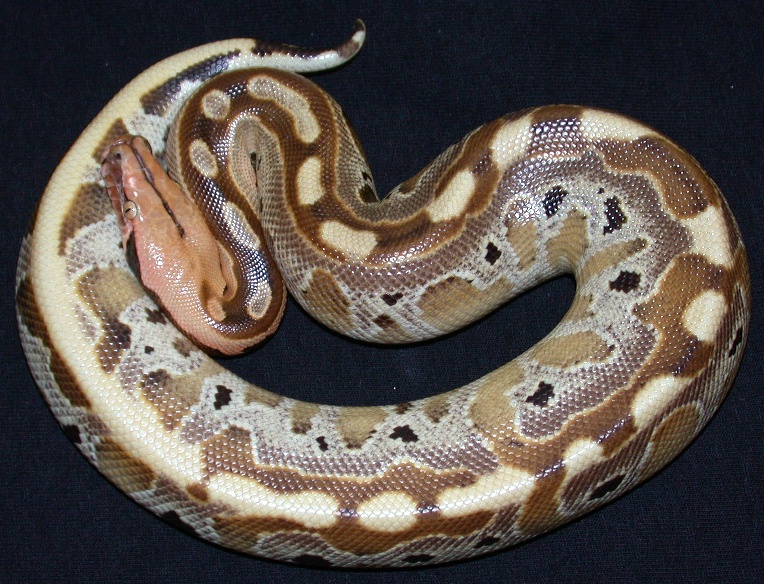Post by Ceratodromeus on Feb 3, 2015 0:25:27 GMT 5
Borneo Python - Python breitensteini

Scientific Classification
Kingdom: Animalia
Phylum: Chordata
Subphylum: Vertebrata
Class: Reptilia
Order: Squamata
Suborder: Serpentes
Family: Pythonidae
Genus: Python
Species: P. breitensteini
Description: this snake is very much alike to the other members of the curtus group, and are commonly mistaken for them. however, a keen eye and knowledge of defining characteristics will help differentiate between species(Shine & keogh 2001)
a relevant passage discussing this:
these snakes are very heavily built, and have broad heads seen in the other large pythons. these snakes are very sexually dimorphic, with the females being larger. large females can get 2 meters or longer in length an weigh 15-20kg. True to the common name, this python has a short tapering tail.
individual showing typical coloration and the characteristic short tapering tail of the species

home range: like the common name may suggest, the Borneo python inhabits Borneo, but also occurs in a few spots of southern Asia.
dietary habits: like most python species, this snake eats primarily ectothermic animals. it's larger size would mean it can take larger prey. though this species is rather poorly researched, we can infer it's iet encompasses rodents, birds, an even the occasional reptile.
Reproduction: Breeding season occurs from november to march, with eggs typically being layed in late February. Clutch size varies from 8-20 eggs, which take approximately 60 days to hatch. the young snakes are 5-8 inches in length when they first hatch.
captively bred Neonate coming out of the egg with a visible egg tooth

Captivity: despite being poorly described, this python has become popular over the last two decades. this is, in due part to their magnificient natural colorations. however, they are often remarked to have a "nasty temperament" and will strike often. this can be 'calmed down' if you will, with constant handling and interactions. they are also renown for their striking speed, and have been called "the fastest striking non-venomous snakes", though this hasn't been put through the ringer quite yet.
they have also been selectively bred to show unique color patterns called "morphs -- here are just a few:
marble

Super Stripe:

Ultra breit


Scientific Classification
Kingdom: Animalia
Phylum: Chordata
Subphylum: Vertebrata
Class: Reptilia
Order: Squamata
Suborder: Serpentes
Family: Pythonidae
Genus: Python
Species: P. breitensteini
Description: this snake is very much alike to the other members of the curtus group, and are commonly mistaken for them. however, a keen eye and knowledge of defining characteristics will help differentiate between species(Shine & keogh 2001)
a relevant passage discussing this:
In most cases, P.breitensteini can be distinguished from P.curtus in that the anterior pair of parietal scales are in broad contact at the mid linesuture,while in most cases the anterior parietals of P.curtus are not in contactor are in very weak contact. Melanism is rarely seen in P.breitensteini, while the bodies of adult P.curtus are always melanistic.The pale markings on the bodies of P. curtus tend to be white or grey, while the pale markings on the bodies of P.breitensteini are typically pale yellow ortan.The fundi of the rostral and supralabial pits of P.breitensteini are unpigmented, while on P.curtus the fundi of the labial pits on the rostral and supralabials are darkly pigmented.
these snakes are very heavily built, and have broad heads seen in the other large pythons. these snakes are very sexually dimorphic, with the females being larger. large females can get 2 meters or longer in length an weigh 15-20kg. True to the common name, this python has a short tapering tail.
individual showing typical coloration and the characteristic short tapering tail of the species

home range: like the common name may suggest, the Borneo python inhabits Borneo, but also occurs in a few spots of southern Asia.
dietary habits: like most python species, this snake eats primarily ectothermic animals. it's larger size would mean it can take larger prey. though this species is rather poorly researched, we can infer it's iet encompasses rodents, birds, an even the occasional reptile.
Reproduction: Breeding season occurs from november to march, with eggs typically being layed in late February. Clutch size varies from 8-20 eggs, which take approximately 60 days to hatch. the young snakes are 5-8 inches in length when they first hatch.
captively bred Neonate coming out of the egg with a visible egg tooth

Captivity: despite being poorly described, this python has become popular over the last two decades. this is, in due part to their magnificient natural colorations. however, they are often remarked to have a "nasty temperament" and will strike often. this can be 'calmed down' if you will, with constant handling and interactions. they are also renown for their striking speed, and have been called "the fastest striking non-venomous snakes", though this hasn't been put through the ringer quite yet.
they have also been selectively bred to show unique color patterns called "morphs -- here are just a few:
marble

Super Stripe:

Ultra breit


